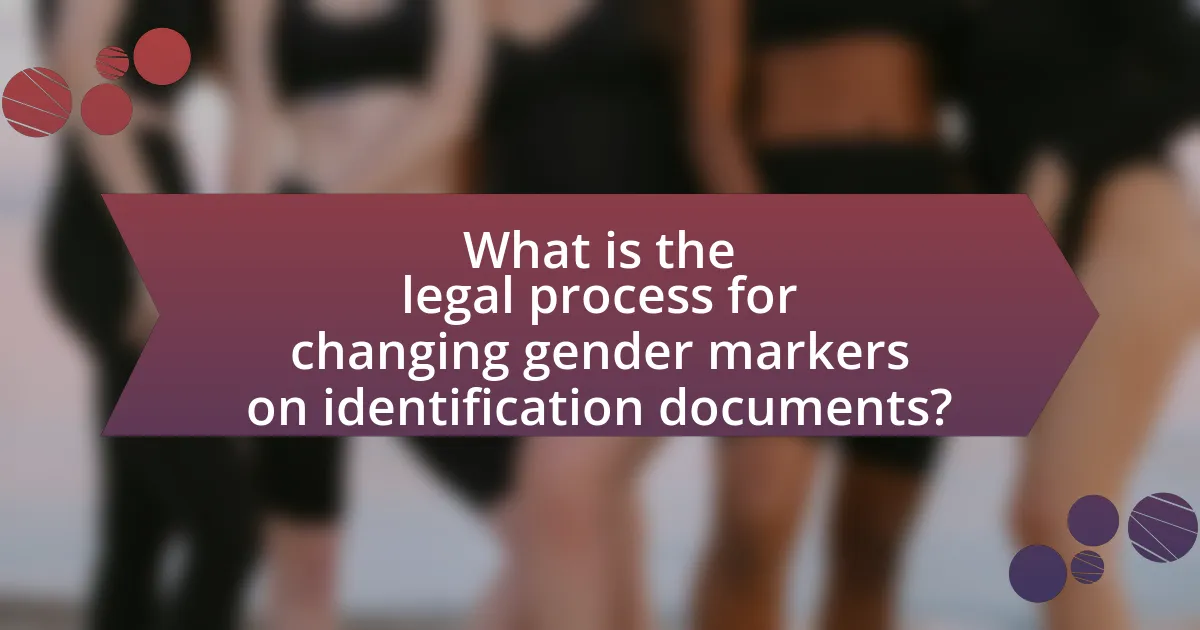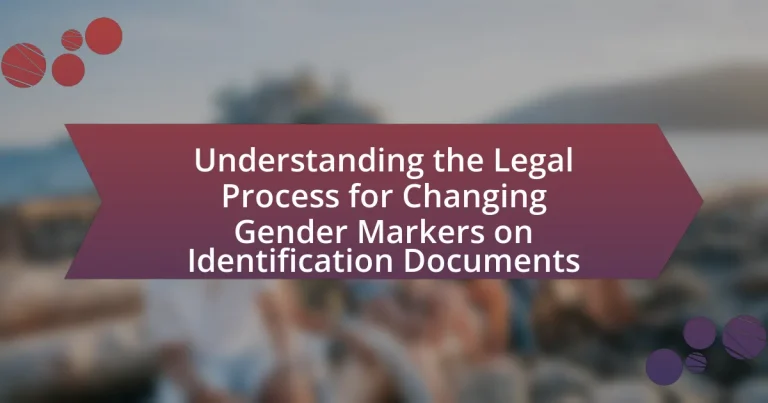The article focuses on the legal process for changing gender markers on identification documents, detailing the requirements and steps involved in various jurisdictions. It highlights the importance of changing gender markers for individuals’ mental health and social acceptance, as well as the psychological and social impacts of such changes. The article outlines the types of documents affected, the specific legal requirements, and the potential challenges individuals may face during the process. Additionally, it provides resources and best practices to assist individuals in navigating the legal landscape effectively.

What is the legal process for changing gender markers on identification documents?
The legal process for changing gender markers on identification documents typically involves submitting a request to the relevant government agency, often accompanied by supporting documentation such as a court order or a letter from a healthcare provider. This process varies by jurisdiction, with some regions requiring proof of gender transition while others may have more lenient requirements. For example, in many U.S. states, individuals must provide a signed statement from a licensed healthcare professional affirming that they are undergoing gender transition. Additionally, some jurisdictions allow for a self-attestation process, where individuals can declare their gender identity without additional documentation. This legal framework is supported by various state laws and policies that aim to recognize and affirm individuals’ gender identities in official records.
Why is changing gender markers important for individuals?
Changing gender markers is important for individuals because it aligns their legal identity with their gender identity, which can significantly impact their mental health and social acceptance. Accurate gender markers on identification documents help reduce discrimination and stigma, facilitating smoother interactions in various aspects of life, such as employment, healthcare, and legal matters. Research indicates that individuals who have their gender markers changed report lower levels of anxiety and depression, highlighting the psychological benefits of having their identity recognized legally.
What are the psychological and social impacts of gender marker changes?
Gender marker changes have significant psychological and social impacts, primarily enhancing individual well-being and social acceptance. Research indicates that individuals who change their gender markers often experience reduced anxiety, depression, and improved self-esteem, as affirmed by a study published in the Journal of Homosexuality, which found that legal recognition of gender identity correlates with better mental health outcomes. Socially, these changes can lead to increased visibility and acceptance within communities, fostering a sense of belonging and reducing stigma. Furthermore, a report by the Williams Institute highlights that legal gender recognition can improve access to healthcare and social services, further supporting the overall quality of life for transgender individuals.
How does society perceive individuals with different gender markers?
Society perceives individuals with different gender markers through a lens of varying acceptance and understanding, often influenced by cultural, social, and legal contexts. Individuals who identify outside traditional gender binaries may face stigma, discrimination, or marginalization, as evidenced by studies indicating that transgender and non-binary individuals experience higher rates of violence and mental health issues compared to their cisgender counterparts. For instance, the 2021 National Transgender Discrimination Survey found that 47% of respondents reported being sexually assaulted at some point in their lives, highlighting societal challenges faced by those with non-conforming gender markers. Conversely, there is a growing movement towards acceptance and inclusivity, with many advocating for legal recognition and rights for individuals to change their gender markers on identification documents, reflecting a shift in societal attitudes towards gender diversity.
What types of identification documents can have gender markers changed?
Identification documents that can have gender markers changed include passports, driver’s licenses, birth certificates, and state-issued identification cards. These documents are often subject to specific legal processes that vary by jurisdiction. For instance, many states in the U.S. allow individuals to update their driver’s licenses and state IDs to reflect their gender identity, typically requiring a court order or a letter from a healthcare provider. Similarly, some jurisdictions permit changes to birth certificates, often necessitating proof of gender-affirming surgery or a declaration from a medical professional. The ability to change gender markers on these documents is supported by various legal frameworks aimed at recognizing and affirming individuals’ gender identities.
Which documents are most commonly affected by gender marker changes?
The documents most commonly affected by gender marker changes include birth certificates, driver’s licenses, passports, and social security records. These documents are critical for establishing identity and legal recognition of an individual’s gender. For instance, many jurisdictions allow individuals to update their birth certificates and driver’s licenses to reflect their gender identity, which is essential for accurate identification in various legal and social contexts.
Are there differences in processes for various types of documents?
Yes, there are differences in processes for various types of documents when changing gender markers on identification documents. Each document type, such as birth certificates, driver’s licenses, and passports, has its own specific requirements and procedures dictated by state or national laws. For instance, some jurisdictions may require a court order for a birth certificate change, while others may only need a signed affidavit from a healthcare provider. This variation is supported by legal frameworks, such as the American Medical Association’s guidelines, which outline differing standards for updating gender markers across various identification forms.
What are the general steps involved in the legal process?
The general steps involved in the legal process for changing gender markers on identification documents include filing a petition, obtaining a court order, and updating the identification documents. Initially, an individual must file a petition with the appropriate court, which typically requires providing evidence of gender identity, such as medical documentation or affidavits. Following the petition, a court hearing may be scheduled where the individual presents their case. If the court grants the petition, a court order is issued, allowing the individual to update their identification documents with the new gender marker. Finally, the individual submits the court order to relevant agencies, such as the Department of Motor Vehicles or vital records offices, to amend their identification documents accordingly.
What initial documentation is required for the process?
The initial documentation required for the process of changing gender markers on identification documents typically includes a government-issued identification, proof of residency, and a letter from a licensed healthcare professional affirming the individual’s gender identity. These documents are essential as they establish the individual’s identity and support the request for a change in gender marker. For instance, many jurisdictions require a letter from a therapist or doctor who has treated the individual, which serves as validation of the gender identity change.
How do individuals submit their requests for changes?
Individuals submit their requests for changes to gender markers on identification documents by completing a specific application form provided by the relevant government agency. This process typically requires individuals to provide supporting documentation, such as a court order or a letter from a licensed healthcare professional affirming their gender identity. The submission is usually made in person or via mail to the designated office, which varies by jurisdiction. This procedure is established to ensure that requests are processed in accordance with local laws and regulations governing the amendment of personal identification records.

What legal requirements must be met to change gender markers?
To change gender markers on identification documents, individuals typically must provide legal documentation that supports their request, which may include a court order, a physician’s statement, or proof of gender-affirming treatment. Many jurisdictions require individuals to submit an application to the relevant government agency, along with the necessary supporting documents, to initiate the process. For instance, some states in the U.S. mandate that applicants demonstrate they have undergone a medical transition or have received a diagnosis of gender dysphoria from a qualified healthcare provider. Additionally, some regions may have specific forms or fees associated with the application process.
What are the eligibility criteria for changing gender markers?
The eligibility criteria for changing gender markers typically include being of legal age, providing proof of gender identity, and sometimes undergoing medical or psychological evaluation. Many jurisdictions require individuals to submit a formal application along with documentation such as a court order, a letter from a healthcare provider, or evidence of gender transition. For instance, some states in the U.S. allow changes based solely on self-identification, while others may mandate surgical procedures or hormone therapy as prerequisites. These requirements vary significantly by location, reflecting differing legal standards and societal attitudes toward gender identity.
Are there age restrictions for individuals seeking changes?
Yes, there are age restrictions for individuals seeking changes to gender markers on identification documents. Typically, many jurisdictions require individuals to be at least 18 years old to apply for a legal gender marker change. However, some places allow minors to petition for changes with parental consent or through a court process. For instance, in California, individuals aged 14 and older can request a gender marker change with parental consent. These age restrictions are established to ensure that individuals have the maturity to understand the implications of such changes and to protect the rights of minors in legal matters.
What documentation is needed to prove eligibility?
To prove eligibility for changing gender markers on identification documents, individuals typically need to provide a court order or a letter from a licensed healthcare professional affirming their gender identity. This documentation is essential as it validates the individual’s request for a change in gender marker. Many jurisdictions require specific forms or statements from healthcare providers that confirm the individual’s transition process or gender identity, ensuring compliance with local laws and regulations governing such changes.
What legal documents are necessary for the process?
The legal documents necessary for changing gender markers on identification documents typically include a court order recognizing the name and gender change, a physician’s letter affirming the individual’s gender identity, and any existing identification documents that require updating. These documents are essential as they provide the legal basis for the change and ensure compliance with state or national regulations governing identification modifications. For instance, many jurisdictions require a court order to officially recognize the change, while medical documentation is often needed to validate the individual’s gender identity as part of the process.
How does a court order facilitate the change of gender markers?
A court order facilitates the change of gender markers by providing legal recognition of an individual’s gender identity, which is essential for updating identification documents. This legal document serves as an official acknowledgment that the individual has undergone a gender transition, allowing them to request changes to their birth certificate, driver’s license, and other official records. Courts typically require evidence of gender transition, such as medical documentation or personal testimony, to issue the order, ensuring that the process adheres to legal standards and protects the individual’s rights.
What role does a medical certification play in the process?
A medical certification plays a crucial role in the legal process for changing gender markers on identification documents by providing official documentation of an individual’s gender identity. This certification, typically issued by a licensed healthcare provider, serves as evidence that the individual has undergone necessary medical evaluations or treatments related to gender transition. Many jurisdictions require this certification to validate the request for a gender marker change, ensuring that the process aligns with legal standards and protects the rights of individuals seeking to reflect their true identity on official documents.
What are the potential legal challenges during the process?
Potential legal challenges during the process of changing gender markers on identification documents include bureaucratic hurdles, varying state laws, and potential discrimination. Bureaucratic hurdles often arise from complex application procedures and requirements that differ significantly across jurisdictions. For instance, some states may require a court order or medical documentation, while others may have more lenient processes. Varying state laws can lead to inconsistencies in recognition and acceptance of gender marker changes, complicating the process for individuals moving between states. Additionally, individuals may face discrimination or bias from officials during the application process, which can hinder their ability to obtain the desired changes. These challenges highlight the need for clear legal frameworks and protections to support individuals seeking to change their gender markers on identification documents.
What common obstacles do individuals face when changing gender markers?
Individuals face several common obstacles when changing gender markers, including legal barriers, financial costs, and social stigma. Legal barriers often arise from varying state or country-specific requirements, such as the need for medical documentation or court orders, which can complicate the process. Financial costs can include fees for legal services, court filings, and potential medical expenses, making it economically challenging for some individuals. Social stigma may lead to discrimination or lack of support from family, friends, or institutions, further complicating the transition process. These obstacles collectively hinder the ability of individuals to successfully change their gender markers on identification documents.
How can individuals prepare for potential legal disputes?
Individuals can prepare for potential legal disputes by gathering and organizing relevant documentation, such as identification documents, medical records, and any correspondence related to the legal matter. This preparation is crucial because having comprehensive and accurate records can significantly strengthen an individual’s position in a dispute. For instance, in the context of changing gender markers on identification documents, individuals should ensure they have all necessary legal forms completed and any required medical documentation that supports their request. Additionally, consulting with a legal professional who specializes in gender identity issues can provide tailored guidance and increase the likelihood of a favorable outcome.

How can individuals navigate the process effectively?
Individuals can navigate the process of changing gender markers on identification documents effectively by thoroughly researching the specific legal requirements in their jurisdiction. Each state or country has distinct procedures, forms, and documentation needed, such as proof of gender transition or a court order. For instance, in the United States, many states allow individuals to change their gender marker by submitting a form to the Department of Motor Vehicles or vital records office, often requiring a signed letter from a healthcare provider. Understanding these requirements ensures that individuals can prepare the necessary documentation and avoid delays. Additionally, seeking support from local LGBTQ+ organizations can provide guidance and resources tailored to the specific legal landscape, enhancing the likelihood of a smooth process.
What resources are available to assist individuals in the process?
Resources available to assist individuals in the process of changing gender markers on identification documents include legal aid organizations, government websites, and support groups. Legal aid organizations, such as the Transgender Legal Defense and Education Fund, provide free legal assistance and guidance on the necessary steps and documentation required for the process. Government websites, like those of state departments of vital records, offer specific instructions and forms needed to apply for a gender marker change. Additionally, support groups, such as PFLAG and local LGBTQ+ centers, provide emotional support and share experiences that can help individuals navigate the legal process effectively.
Which organizations provide support for legal gender marker changes?
Organizations that provide support for legal gender marker changes include the National Center for Transgender Equality, Lambda Legal, and the Transgender Legal Defense and Education Fund. These organizations offer resources, legal assistance, and advocacy to help individuals navigate the process of changing their gender markers on identification documents. For instance, the National Center for Transgender Equality has published guides and resources that outline the steps required in various states, demonstrating their commitment to supporting transgender individuals in achieving legal recognition of their gender identity.
What online tools can help individuals understand their rights?
Online tools that can help individuals understand their rights include legal information websites, government resources, and advocacy organization platforms. Websites like Nolo and FindLaw provide comprehensive legal guides and articles that explain rights related to gender marker changes. Government resources, such as state or federal websites, often outline the legal processes and rights associated with identification documents. Additionally, advocacy organizations like the Human Rights Campaign and the National Center for Transgender Equality offer specific resources and toolkits that detail rights and procedures for changing gender markers on identification documents. These tools are validated by their extensive use in legal education and advocacy, ensuring individuals have access to accurate and relevant information.
What best practices should individuals follow during the process?
Individuals should gather all necessary documentation before initiating the process of changing gender markers on identification documents. This includes obtaining legal documents such as a court order or a physician’s letter affirming the individual’s gender identity. Additionally, individuals should familiarize themselves with the specific requirements and procedures of their jurisdiction, as these can vary significantly. For instance, some states require a notarized affidavit or specific forms to be completed. Understanding these requirements ensures a smoother process and reduces the likelihood of delays or rejections.
How can individuals ensure they have all necessary documentation?
Individuals can ensure they have all necessary documentation by creating a comprehensive checklist of required documents specific to the legal process for changing gender markers on identification documents. This checklist should include items such as proof of identity, medical documentation affirming gender transition, and any court orders if applicable. Research indicates that many jurisdictions require specific forms of identification and supporting documents, which can vary widely; therefore, consulting local government resources or legal aid organizations can provide accurate guidance tailored to individual circumstances.
What tips can help streamline the legal process for changing gender markers?
To streamline the legal process for changing gender markers, individuals should gather all necessary documentation beforehand, including identification, medical letters, and any required forms specific to their jurisdiction. Ensuring that all paperwork is complete and accurate minimizes delays and potential rejections. Additionally, consulting with legal professionals who specialize in gender marker changes can provide tailored guidance and help navigate complex legal requirements. Research indicates that jurisdictions with clear guidelines and supportive legal frameworks facilitate smoother transitions, highlighting the importance of understanding local laws and procedures.





